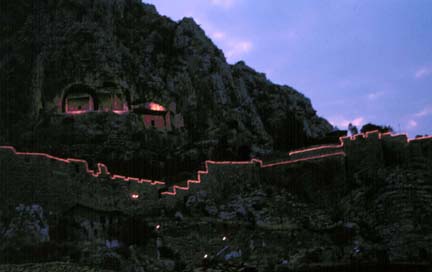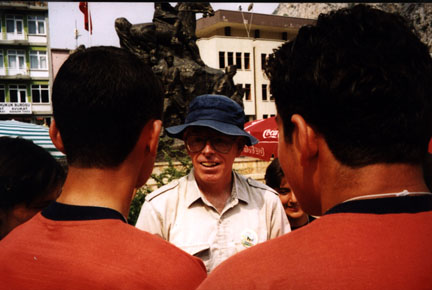
The predawn sky behind the illuminated Pontic Tombs was completely overcast.
Meteorological and electrical disaster?
I awoke to gloom. Clouds covered the sky. The whole sky. However even amid the gloom there was hope. These clouds were very much like the clouds we see most every morning in California. They looked like they would burn off as the day went on.

We went on with our preparations. Larry, Aaron and Kurt worked at the site most of the night, Zane actually slept there in a sleeping bag borrowed from Cheri. Larry and Cheri worked together to align the equatorial mount of the telescope so that it pointed to the North celestial pole, near Polaris. It was hard work in the glare of the streetlights and the haze that preceded the coming of the clouds, but they pushed on through failures to final success.
The transmitter on our Inmarsat link failed so we lost one set of phone communication with the Exploratorium. Luckily the Turkish Television satellite communication truck arrived and allowed us to establish video and audio communication with the Exploratorium. When Zane was setting up the Inmarsat transmitter he looked up to see he was surrounded by a wall of Turkish men, drawn like flies to this display of high-technology!
At first we were elated when Larry unscrewed a metal plate at the bottom of a metal electric power line pole and found a plug! Unfortunately the plug wasn't connected. I was appalled when a lineman climbed up a metal pole and spliced our power lines into the live 220 volt power lines that crossed above the square. He then climbed calmly down. I thought "don't try this at home!"
As the morning progressed the clouds began to thin. But I got the same question over and over from the gathering crowds. Will the weather clear? I told them that I gave it a 50-50 chance of clearing. I said if I were mobile I'd drive up onto the plateau above town, look for a clearing in the clouds and drive there to watch the eclipse. As I watched the clouds however, I noticed an interesting pattern developing. The strato-cumulus clouds of morning were gathering into widely separated cumulus towers. These towers would approach Amasya from the southeast and then dissipate as they hit a flow of descending air flowing off the plateau and down into the valley of Amasya. It began to look like we'd have a good chance of seeing the eclipse after all.
Then just before first contact I heard a pop and a fizzle and saw smoke coming from the tangle of wires. Larry dived into the smoke unplugging wires quickly and precisely. Aaron began checking the every audio and video device. He was quickly determining what was working and what wasn't. The engineers in the satellite truck opened the door and called out that they had lost our signal. The worst thing had happened, just before the eclipse we had blown a power strip. The power strip may have disabled many elements of our system. In a display of technical ingenuity that would have done a team of NASA specialists proud. Larry and Aaron debugged, rewired, patched around, and managed to get things working again. They essentially reassembled an audio/video production facility in a few minutes that they had taken over twenty hours to assemble and tune in the first place. In an image I'll never forget Aaron finally ran back to his control console, turned everything on and the entire system came to life. He then collapsed into his chair in relief.
Visitors kept coming up to us and asking us to check the safety of their eclipse viewing devices. Some were good - there were a surprising number of #14 welders glasses - some were questionable - dark photographic negatives, others were dangerous - sunglasses and candle smoked glass. We gave out many pairs of eclipse viewing glasses concentrating on replacing the dangerous viewers with safe ones.

Our Explainers arrived and began to work the crowd. They started showing the crowd how to project sun images with pinholes and warned them not to look at the partial eclipse without a viewer. Cheri set up the binoculars to project the sun and its spots. Nahide Craig a NASA Astrophysicist originally from Turkey roamed the crowd herself answering everyone's questions on eclipses. Aaron tuned the video and the sound, Larry took fatherly care of the telescopes. Kurt gave us all the plan for the day and he and Zane worked over all of the complex communications between the Exploratorium and Amasya. Hrappa our Icelandic camera woman was joined by Nurshan our Turkish translator who just happened to be a graduate student studying film at San Francisco State University and who could use a camera like a seasoned professional. We had a small team with a lot to do. The eclipse shadow was coming toward us at 1500 miles per hour. We had better be ready.
The clouds were clearing quickly now. Over half the sky was blue. We were high on expectations of seeing the eclipse.
At 1 PM there was a call to prayer from the nearby mosque. Just as the call ended the disk of the moon moved between the edge of the sun and Amasya, first contact, the eclipse had begun. 500 people filled the town square, thousands of people filled the Exploratorium, a hundred thousand people tuned in to the Exploratorium website, millions of people watched the 17 television networks to which we were sending our images from Amasya. We were glad to get a message from ABC TV in New York it said simply "your signal rocks!"
Visit the Exploratorium web pages for more information on eclipses:
Links to other eclipse stories:
Eclipse Disaster, the story of a partial solar eclipse in the Exploratorium's front yard.
Going Up? Get Fit! Adapting to high altitude for the eclipse in Chile.
|
Scientific Explorations with Paul Doherty |
|
27 July 99 |